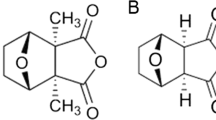Abstract
Purpose: 9-Nitrocamptothecin (9-NC) and 12-nitrocamptothecin (12-NC) are synthetic structural analogues of camptothecin (CPT) which have been prepared to explore the structure/activity relationship of this group of compounds against a wide variety of experimental tumors. As part of our investigation of the pharmacology and the mechanism of tumor inhibition of these compounds, we examined the effect of route of administration on the distribution of tritium-labeled 9-NC and 12-NC, an active and a poor chemotherapeutic agent, respectively. Methods: Quantitative whole-body autoradiography was used and our results were compared with previous results obtained with the parent compound CPT. Results: These studies revealed that, independent of the route of administration, both CPT derivatives were rapidly distributed to gall bladder, gastrointestinal tract and kidney. The excretion from these organs was indicated by the high levels of radioactivity in urine (urinary bladder) and feces (large intestines). The studies also indicated that the distributions of 9-NC and 12-NC were qualitatively similar, but quantitatively higher uptake of radioactivity was observed in animals treated with 12-NC than in those treated with 9-NC at 30 min following treatment. With the exception of the late sampling time (12 h after administration), the accumulation of radioactivity in the lungs (bronchioles) of animals that received an intravenous (i.v.) dose of 9-NC or 12-NC was higher than those treated with an intramuscular (i.m.) dose. However, the retention of drug-derived radioactivity in the tumors of mice treated with an i.m. dose of 9-NC was higher than that in the tumors of i.v.-treated animals and was also higher than that in tumors of animals treated with 12-NC. Conclusions: These results suggest that higher accumulation of 9-NC in tumor tissues than of 12-NC may contribute to the more potent chemotherapeutic activity of the former agent. Our results also suggest that i.m. injection is a more effective route of administration than i.v. administration.
Similar content being viewed by others
Author information
Authors and Affiliations
Additional information
Received: 22 November 1996 / Accepted: 4 April 1997
Rights and permissions
About this article
Cite this article
Ahmed, A., Jacob, S., Giovanella, B. et al. Comparative disposition of the antineoplastic agent 9-nitrocamptothecin and the inactive isomer 12-nitro camptothecin in CASE-bearing nude mice: effect of route of administration on tissue distribution. Cancer Chemother Pharmacol 41, 29–36 (1997). https://doi.org/10.1007/s002800050704
Issue Date:
DOI: https://doi.org/10.1007/s002800050704



